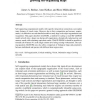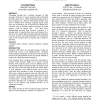146 search results - page 27 / 30 » Human Action Recognition Using Segmented Skeletal Features |
IJON
2002
13 years 7 months ago
2002
Self-organizing computational models with specific intracortical connections can explain many features of visual cortex. However, due to their computation and memory requirements,...
AIPR
2008
IEEE
13 years 9 months ago
2008
IEEE
We present an agent-based full body tracking and 3D animation system to generate motion data using stereo calibrated cameras. The novelty of our approach is that agents are bound t...
MM
2006
ACM
14 years 1 months ago
2006
ACM
Human vision system actively seeks interesting regions in images to reduce the search effort in tasks, such as object detection and recognition. Similarly, prominent actions in v...
CHI
2002
ACM
14 years 7 months ago
2002
ACM
Navigating through new voicemail messages to find messages of interest is a time-consuming task, particularly for high-volume users. When checking messages under a time constraint...
AMDO
2006
Springer
13 years 11 months ago
2006
Springer
The ability to detect and track human heads and faces in video sequences is useful in a great number of applications, such as human-computer interaction and gesture recognition. Re...


